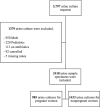Prevalence of urinary tract infections in pregnant women and antimicrobial resistance patterns in women in Riyadh, Saudi Arabia: a retrospective study
- PMID: 38762526
- PMCID: PMC11102606
- DOI: 10.1186/s12879-024-09385-y
Prevalence of urinary tract infections in pregnant women and antimicrobial resistance patterns in women in Riyadh, Saudi Arabia: a retrospective study
Abstract
Background: Urinary tract infections (UTIs) are one of the most common health problems worldwide and mainly affect women. This study aimed to evaluate the prevalence of UTIs in pregnant women and determine the antimicrobial resistance patterns of bacterial pathogens isolated from pregnant and nonpregnant women in Riyadh, Saudi Arabia.
Methods: This retrospective cohort study was conducted at an academic medical center in Riyadh, Saudi Arabia, from January to June 2022. The study included all urine cultures performed for adult women during the study period. We excluded urine culture performed for women on antibiotics prescribed for any infection, children, and men. Using the SPSS (version 27) package, descriptive statistics and chi-square tests were used to analyze the data, and p < 0.05 was considered to indicate statistical significance.
Results: A total of 2,418 urine cultures performed during the study period were included (985 and 1,433 for pregnant and nonpregnant women, respectively). The overall prevalence of UTIs in pregnant women was 5% (95% CI 3.6-6.4); 10 (1%) women were symptomatic, and 40 (4%) women were asymptomatic. Of the entire cohort, 244 (10.1%) women were diagnosed with UTIs based on bacterial cultures. The predominant bacteria in both pregnant and nonpregnant women were Escherichia coli (134, 54.9%), followed by Klebsiella pneumoniae (48, 19.6%). The antibiotic susceptibility criteria for Escherichia coli and Klebsiella pneumoniae were as follows: nitrofurantoin (94% and 18.8%, respectively), amoxicillin-clavulanic acid (82.8% and 70.8%, respectively), ciprofloxacin (65.7% and 83.3%, respectively), trimethoprim-sulfamethoxazole (65.7% and 79.2%, respectively) and cephalothin (47% and 68.8%, respectively).
Conclusion: Compared to the findings of other similar studies, the prevalence of UTIs was lower in pregnant women. This may be because the patient population was composed of healthy and educated women who received prenatal education and underwent prenatal assessment as per institutional guidelines. Nitrofurantoin and amoxicillin-clavulanic acid are recommended for use as an empirical therapy for UTIs in pregnant and nonpregnant women because bacteria have the least amount of resistance to these drugs.
Keywords: Pregnant; Prenatal education; Prevalence; Saudi Arabia; Susceptibility; Urinary tract pathogens.
© 2024. The Author(s).
Conflict of interest statement
The authors declare no competing interests.
Figures
Similar articles
-
Prevalence and Resistance Patterns of Urinary Tract Infection in Al-Madinah Al-Munawarah, Saudi Arabia: A Retrospective Study.Discov Med. 2024 Apr;36(183):853-864. doi: 10.24976/Discov.Med.202436183.80. Discov Med. 2024. PMID: 38665033
-
An evaluation of E. coli in urinary tract infection in emergency department at KAMC in Riyadh, Saudi Arabia: retrospective study.Ann Clin Microbiol Antimicrob. 2018 Feb 9;17(1):3. doi: 10.1186/s12941-018-0255-z. Ann Clin Microbiol Antimicrob. 2018. PMID: 29422058 Free PMC article.
-
Frequency of drug-resistant bacterial isolates among pregnant women with UTI in maternity and children's hospital, Bisha, Saudi Arabia.Sci Rep. 2024 Mar 28;14(1):7397. doi: 10.1038/s41598-024-58275-5. Sci Rep. 2024. PMID: 38548851 Free PMC article.
-
Antimicrobial resistance among pregnant women with urinary tract infections is on rise: Findings from meta-analysis of observational studies.J Infect Public Health. 2024 Jul;17(7):102467. doi: 10.1016/j.jiph.2024.05.055. Epub 2024 May 31. J Infect Public Health. 2024. PMID: 38850585 Review.
-
Fosfomycin trometamol: a review of its use as a single-dose oral treatment for patients with acute lower urinary tract infections and pregnant women with asymptomatic bacteriuria.Drugs. 2013 Nov;73(17):1951-66. doi: 10.1007/s40265-013-0143-y. Drugs. 2013. PMID: 24202878 Review.
Cited by
-
Incidence of extended spectrum beta-lactamase (ESBL) producing Escherichia coli isolated from women with urinary tract infections in Jordan.Iran J Microbiol. 2025 Feb;17(1):41-50. doi: 10.18502/ijm.v17i1.17800. Iran J Microbiol. 2025. PMID: 40330060 Free PMC article.
References
-
- Abate D, Marami D, Letta S. Prevalence, antimicrobial susceptibility pattern, and associated factors of urinary tract infections among pregnant and nonpregnant women at public health facilities, Harar, eastern Ethiopia: a comparative cross-sectional study. Can J Infect Dis Med Microbiol. 2020;2020:e9356865. doi: 10.1155/2020/9356865. - DOI - PMC - PubMed
-
- Kiiru S, Maina J, Katana J, Mwaniki J, Asiimwe BB, Mshana SE, Keenan K, Gillespie SH, Stelling J, Kiiru J, Holden MTG, Consortium H. Bacterial etiology of urinary tract infections in patients treated at Kenyan health facilities and their resistance toward commonly used antibiotics. medRxiv. 2023:2022.10.25.22281521. 10.1101/2022.10.25.22281521. - PMC - PubMed
MeSH terms
LinkOut - more resources
Full Text Sources
Medical


